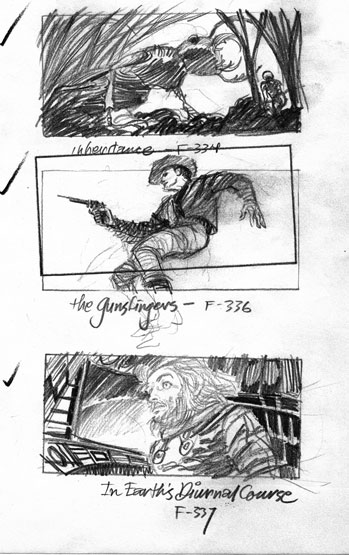 (Prelim spot art sketches by Jack Gaughan for Ace paperbacks c. 1965)
(Prelim spot art sketches by Jack Gaughan for Ace paperbacks c. 1965)
THE NEW YORKER magazine recently had a post titled “Bring Back the Illustrated Book!”. The piece outlines a time when profusely illustrated books were commonplace. When authors such as Dickens, Lewis Carroll, George Bernard Shaw and Dos Passos were paired with artists such as George Cruikshank, John Tenniel, John Farleigh and Reginald Marsh. We are told, “ … in each case the author relied on the artwork not only to enhance the aesthetic appeal of the book but to add meaningfully to the story.” It seems that by the early 20th Century this publishing custom was already on the wan. Today it is rare to find an adult fiction book with interior illustrations.
Many old time science fiction fans who collect science fiction pulp and digest magazines already known about the great illustrators that served to enhance these publications. Hannes Bok, Virgil Finlay, Ed Emshwiller, Kelly Freas and other gifted artists were a vital part of these magazines. But there was also a heyday during the latter part of the 1960s into the beginning part of the 1970s when quite a few science fiction books, mainly anthologies, also contained interior illustrations. The high point of this practice may have been Harlan Ellison’s Dangerous Visions anthologies, the first illustrated by Leo and Diane Dillon and the second by Emshwiller.
One of our favorite artists Jack Gaughan illustrated a number of genre books for Ace Books, and later DAW, including the annual World’s Best Science Fiction series edited by Donald A. Wollheim and Terry Carr. Growing up in New York City I would buy these collections in downtown used bookstores and remember wondering why all books weren’t similarly illustrated. I had the feeling even then that modern publishers considered the practice suitable only for juvenile books. But there was a time when it was mature enough for Dickens and George Bernard Shaw.
While we don’t see the wide-spread return of illustrated adult books, we would like to point out that every story in the Nonstop anthology Steampunk Prime, edited by Mike Ashley, is illustrated in a manner inspired by Ace Books back in the day and Nonstop Press does have plans to do more anthologies using this format. They do work well as ebooks, serving to break up long blocks of text on e-reader screens, and of course improve the aesthetic appeal of the whole package.
Write a Comment